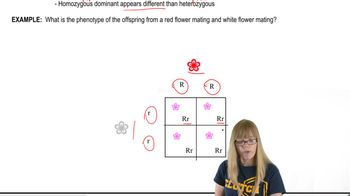Table of contents
- 1. Introduction to Genetics51m
- 2. Mendel's Laws of Inheritance3h 37m
- 3. Extensions to Mendelian Inheritance2h 41m
- 4. Genetic Mapping and Linkage2h 28m
- 5. Genetics of Bacteria and Viruses1h 21m
- 6. Chromosomal Variation1h 48m
- 7. DNA and Chromosome Structure56m
- 8. DNA Replication1h 10m
- 9. Mitosis and Meiosis1h 34m
- 10. Transcription1h 0m
- 11. Translation58m
- 12. Gene Regulation in Prokaryotes1h 19m
- 13. Gene Regulation in Eukaryotes44m
- 14. Genetic Control of Development44m
- 15. Genomes and Genomics1h 50m
- 16. Transposable Elements47m
- 17. Mutation, Repair, and Recombination1h 6m
- 18. Molecular Genetic Tools19m
- 19. Cancer Genetics29m
- 20. Quantitative Genetics1h 26m
- 21. Population Genetics50m
- 22. Evolutionary Genetics29m
2. Mendel's Laws of Inheritance
Probability and Genetics
Problem 42
Textbook Question
In four o'clock plants, many flower colors are observed. In a cross involving two true-breeding strains, one crimson and the other white, all of the F₁ generation were rose color. In the F₂, four new phenotypes appeared along with the P₁ and F₁ parental colors. The following ratio was obtained:1/16 crimson 4/16 rose2/16 orange 2/16 pale yellow1/16 yellow 4/16 white2/16 magentaPropose an explanation for the inheritance of these flower colors.
 Verified step by step guidance
Verified step by step guidance1
Step 1: Recognize that the inheritance pattern involves multiple phenotypes, suggesting polygenic inheritance or interaction between multiple genes. The presence of intermediate phenotypes (e.g., rose color in F₁) indicates incomplete dominance or gene interaction.
Step 2: Analyze the phenotypic ratio in the F₂ generation. The ratio (1/16, 4/16, 2/16, etc.) suggests a dihybrid cross with two genes, each having two alleles, and their interaction determines the flower color.
Step 3: Assign gene symbols to represent the traits. For example, let 'A' and 'B' represent two genes involved in flower color. Each gene has two alleles: A (dominant) and a (recessive), B (dominant) and b (recessive). The combinations of these alleles produce different phenotypes.
Step 4: Consider the interaction between the two genes. For instance, the combination of dominant alleles (A and B) might produce crimson, while other combinations (e.g., AaBb, Aabb, etc.) result in intermediate colors like rose, orange, or pale yellow. Recessive combinations (aabb) might produce white.
Step 5: Use a Punnett square to predict the genotypic combinations in the F₂ generation. Calculate the phenotypic ratios based on the gene interactions and assign colors to each genotype. This will explain the observed phenotypic ratio in the F₂ generation.
 Verified video answer for a similar problem:
Verified video answer for a similar problem:This video solution was recommended by our tutors as helpful for the problem above
Video duration:
1mPlay a video:
Was this helpful?
Key Concepts
Here are the essential concepts you must grasp in order to answer the question correctly.
Mendelian Inheritance
Mendelian inheritance refers to the principles of heredity established by Gregor Mendel, which include the concepts of dominant and recessive traits. In this case, the crimson and white flower colors represent two alleles, where one may be dominant over the other. The F₁ generation displaying a rose color suggests incomplete dominance, where neither allele is completely dominant, resulting in a blend of traits.
Recommended video:
Guided course

Organelle Inheritance
Phenotypic Ratios
Phenotypic ratios describe the relative frequencies of different phenotypes in the offspring of a genetic cross. The observed 1:4:2:2:1:4:2 ratio in the F₂ generation indicates a complex inheritance pattern, likely involving multiple alleles and possibly epistasis, where one gene affects the expression of another, leading to the variety of flower colors.
Recommended video:
Guided course

Mutations and Phenotypes
Multiple Alleles and Incomplete Dominance
Multiple alleles refer to the presence of more than two alleles for a genetic trait within a population. In this scenario, the presence of rose, orange, pale yellow, yellow, and magenta colors suggests that multiple alleles are influencing flower color. Incomplete dominance occurs when the heterozygous phenotype is a blend of the two homozygous phenotypes, as seen in the F₁ generation, leading to the diverse phenotypes in the F₂ generation.
Recommended video:
Guided course

Variations on Dominance
Related Videos
Related Practice
Textbook Question
Students taking a genetics exam were expected to answer the following question by converting data to a 'meaningful ratio' and then solving the problem. The instructor assumed that the final ratio would reflect two gene pairs, and most correct answers did. Here is the exam question:'Flowers may be white, orange, or brown. When plants with white flowers are crossed with plants with brown flowers, all the F₁ flowers are white. For F₂ flowers, the following data were obtained:48 white12 orange4 brownConvert the F₂ data to a meaningful ratio that allows you to explain the inheritance of color. Determine the number of genes involved and the genotypes that yield each phenotype.'Solve the problem for two gene pairs. What is the final F₂ ratio?
391
views


